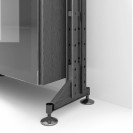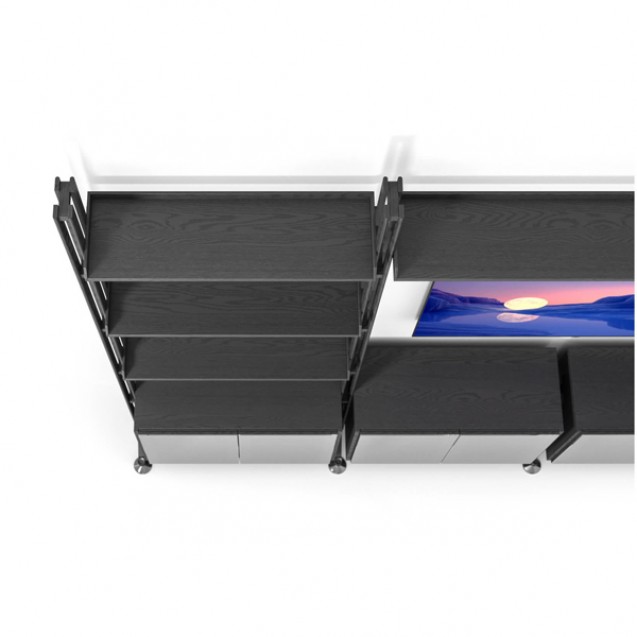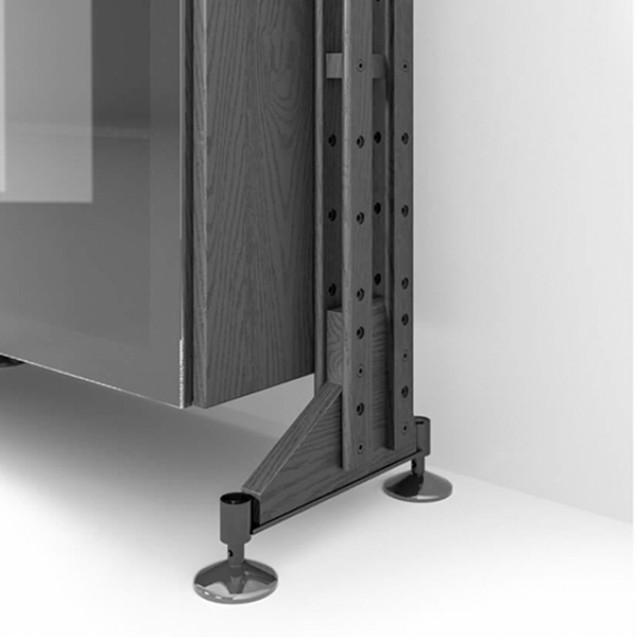835 Infinito Wall
The Infinito bookcase, designed in
1956/7 by Franco Albini, has expanded to include a new fixed to the wall
version with a different and more stable floor support. This model was developed - in constant collaboration with the
Maestro’s heirs - taking as its main reference a project designed by Albini
himself together with Franca Helg in 1958, now on show at the Albini Foundation
headquarters, together with drawings made for its reissue by the company Poggi.
Infinito Wall is an even more contemporary and functional bookcase: thanks to
the insertion of a low upright it is possible to add a dedicated storage unit
with doors to create a compartment above that can hold a TV screen up to
65" with a 165cm shelf above it. The new cupboard can be equipped for the
passage of cables, maintaining visual order and lightness; the doors are also
available in smoked glass for the bookcase in stained black ash. With the introduction of these new modules, the hinges have also
been updated to allow door adjustment and cushioned closure.
| About Designer | |
|---|---|
Franco Albini |
He was a major figure in the Rationalist Movement,
excelling in architectural, furniture, industrial and museum design. After
receiving a degree in architecture from the Politecnico di Milano in 1929, he
worked with the Ponti and Lancia design studios. His work for the magazine
Casabella also played a key part in his development, marking his conversion to
the Rationalist Movement and his becoming its spokesman on the Italian cultural
scene. When he set up
his own practice in Milan in 1931, he took on the challenge of workers’ housing
and continued in this vein after the war, thanks to the opportunities offered
by the reconstruction projects he worked on with Franca Helg from 1952. During the
1940’s, Albini expanded his collaboration with Cassina, which started with
chair designs that paved the way for his signature style. He also pursued his
furniture designs with other firms, such as Poggi. Milan and
Genoa form the geographical axis where Albini left his strongest imprint. For
the Lombard capital, he planned the development of the stations on Line 1 of
the city’s subway system (1962/63), in collaboration with graphic designer Bob
Noorda. His numerous urban development and building projects for Genoa include
the Palazzo Bianco (1949/51), Palazzo Rosso (1952/62), and Tesoro di San
Lorenzo (1952/56) museums. Franco Albini
was the recipient of many honors in recognition of the importance of his
cultural contributions. Among others,
he is a member of the INU, the CIAM, the AccademiaLigustica di Genova, MOMA in
New York, the ADI, the Accademico di S. Luca, the Fondazione Pagano and the
London Royal Society of Arts. He also
received numerous prizes, including the La Rinascente-Compasso d’Oro for the
design of the Luisa chair (1955), the Bronze Medal from the Parson School in
New York (1956) for his contribution to industrial design, the Olivetti Award
for Architecture (1957), the Gran PremioNazionale La Rinascente-Compasso d’Oro
(1958), the La Rinascente-Compasso d’Oro Award for the Milan Line 1 Subway
project (1964), and the Royal Designer for Industry title awarded by the London
Royal Society of Arts (1971). In all his
work, from home furnishings to industrial and museum design projects, Franco Albini
always instilled a logical consistency, an extreme purity of expression and
exceptional ethical and historical integrity.
The
architectural and design work of Franco Albini represents a keystone of the
Italian architectonic culture from the early 20th century through his intense
activity revolving around a creative and rigorous approach to composition and
building that expresses a particularly high degree of estheticism. |












